
Is anybody else geeking out about the visual direction in Limitless?
I mean, every show every movie has its own visual storytelling techniques. Ways and methods of manipulating viewer emotions, foreshadowing, context-setting etc. It’s a known part of the art of visual storytelling, and every production team has their own distinct style.
Of the shows that are currently on the air, however, Limitless has the clearest vocabulary. You can turn the sound off and read the show like you might read the pages of a comic book. You don’t need the words, the changes in luminosity, contrast, color saturation all of these serve the story at all times, and they tell the story so clearly sometimes that the actors don’t need to say a word.
You’ve noticed, I presume, that when our main character, Brian, takes the drug that allows him to be smarter than everybody else (NZT), The entire world gets slightly more saturated. In the occasional shot where they overdo it, Brian looks like a bit like he’s glowing.
They counter this with the rare occasions where Brian is not taking NZT. Everything looks like you would expect human saturation wise, but Brian has a penchant for oversize, ugly, comfortable sweaters and the occasional hoodie thrown in for good measure. Because the “every-man” always wears a hoodie these days.
On the super-negative side (also rare), rather than making the scene go gray, or dimming the lights, when Brian is having a bad emotional reaction, whether it be to his actions on the show or whether it be to negative side effects of NZT, they hype the contrast. Everything in the scene develops a hard edge because the difference between the darks and the lights has been heightened to an almost uncomfortable degree. Â Couple this with some handheld camera work and you have scenes that are visually painful to watch.
Usually this type of lighting language is handled in a much more obvious fashion. Characters having a bad day, they have him sitting in the dark. If your characters having a good day, the sky is blue and there’s not a cloud to be seen. This is the first time I have seen them overtly manipulating things like saturation and contrast in the service of a small-screen story. Adjusting contrast, saturation or hue after-the-fact is a garden-variety post processing effect. Almost every show or movie out there does to some degree, but most of the time it’s done to correct issues that could not be worked around any other way, like having to film on a cloudy day or tweaking the lighting so that a scene shot in the sunset looks like it’s been shot at sunrise.
It’s delightful to see this kind of aggressive visual direction showing up on the small screen. It goes along way towards adding polish and sophistication to an already excellent cast and script.




